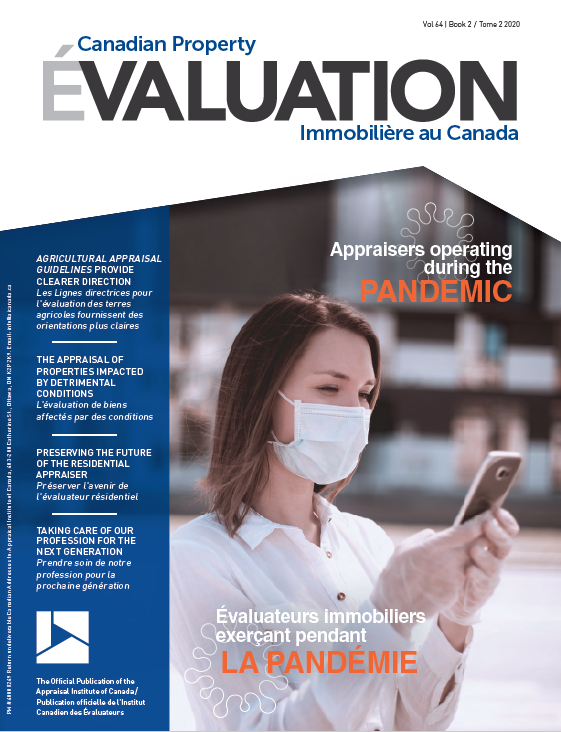Agricultural Appraisal Guidelines provide clearer direction on farmland appraisals
Canadian Property Valuation Magazine
Search the Library Online
Agricultural Appraisal Guidelines provide clearer direction on farmland appraisals
In the fall of 2019, the National Council of Real Estate Investment Fiduciaries (NCREIF, Chicago, Il, – ncreif.org) Farmland Committee published the NCREIF Agricultural Appraisal Guidelines (Guidelines), which represent the first set of comprehensive industry guidelines developed to meet the demanding reporting needs of institutional investors.
The Guidelines are intended to provide a clearly defined set of standards for appraisers who perform farmland appraisals on properties that are managed or owned by contributing members of the NCREIF Farmland Index. They are not intended to replace current appraisal requirements such as those outlined in the Canadian Uniform Standards of Appraisal Practice (CUSPAP), USPAP, or other local/national licensing or valuation requirements, but rather to create consistency and clarity in the appraisal properties that are included in the NCREIF Farmland Index.
According to Rich Matheson, Farmland Portfolio Manager for a US state pension fund and Chair of the NCREIF Farmland Index, “Many hours have been dedicated by multiple members of our committee to develop these guidelines. The primary goals are to assist the agricultural appraisal community by clarifying the content, analyses, and data that institutional investors need, as well as help further the growing demand for the agriculture asset class.”
One of the participants in making this important document a reality was Appraisal Institute of Canada (AIC) Member Scott McEwen, AACI, P. App., who is a Senior Vice President & Sr. Managing Director with CBRE Limited| – Valuation & Advisory Services Agribusiness, Land & Natural Resources. Scott served as Chair of the Valuation Sub-Committee during the drafting of the Guidelines.
“I was honored to be elected by the farmland committee to lead the valuation guidelines group to develop the Guidelines and provide feedback to investors from an appraisal perspective,” says Scott. “My original involvement with the sub-committee was to look at valuation issues and performing fund valuations with participating institutional investors. As a Member of the AIC, I was able to provide a somewhat international viewpoint so that the guidelines could be far reaching and have the ability to travel well – a number of Canadian pension fund investors invest in the US as well as other locations such as Australia and South America. Publishing these guidelines in a two-year window was considered to be a feather in the cap for the team who understood that drafting working valuation guidelines or standards can take a considerable amount of time.” Adhering to a tight two-year timeframe for developing these Guidelines, the group’s goal was to ensure that the Guidelines were adoptable and realistic. This meant achieving buy-in from investors, stakeholders, the NCREIF Valuation Committee (all asset classes), and various other appraisal organizations, so that ‘ownership’ of the Guidelines would not be limited to any one particular organization.
While NCREIF assumed the leadership role in making these Guidelines a reality, other participants included the American Society of Farm Managers and Rural Appraisers (ASFMRA), the Appraisal Institute (AI), two fund managers, and, of course, the AIC.
As background, NCREIF serves the institutional real estate investment community as its data central, representing the largest, most robust and diverse database of country-specific real estate assets in the world. In 1978, the organization produced the first property level return index, the NCREIF Property Index (NPI), which is a quarterly time series composite return measure of investment performance of a large pool of individual farmland properties acquired in the private market for investment purposes only – most investors are pension funds. As of Q4 2019, the Farmland Index had a total market value of $11,440,034,163 USD, with total annual returns of 4.81% (including row crops and permanent crops).
Considering the ongoing increase in demand for farmland investment, a common theme was that, in the process of gathering relevant data, each fund had its own data requirements; there were differing levels of appraisal reporting techniques and standards; and there was little consistency and high levels of variation in appraisal skill sets. Hence the decision by the NCREIF Farmland Committee to form a valuation sub-committee focused on the goals of establishing guidelines for valuation, educating appraisers, expanding property level value attributes, and setting the stage for the long-term adoption of asset benchmarking tools. Guidelines were understood to be the cornerstone of developing better investment level data to stakeholders, so this became the focus of the sub-committee early on.
According to Scott, the development of these Guidelines is significant for Canadian appraisers. “Although it is still well behind the US, Canada’s institutional investment in farmland is growing relatively quickly. This effort to develop ‘best practices’ and provide standards to Canadian investors can only help grow the industry. Hopefully, these will eventually be adopted world-wide. In addition, similar guidelines can be developed for other alternative assets over time.”
While the development of these initial Guidelines is a significant first step, there will be an ongoing need to further develop and regularly update them as valuation standards change in accordance with stakeholder demands. For instance, the valuation of certain agricultural assets will have to adapt to technology innovations such as software programs somewhat similar to Argus. As the Guidelines evolve, the next steps will be identifying key benchmarks for the asset class – comparing these across investor firms and using appraisers to both help develop these benchmarks and track them through appraisal data (lease rates, management fees as a percentage of revenue, discount rates, portfolio premiums, etc.).
As this process moves forward, appraisal industry will be adopting some of these best practices to Canadian farmland valuation over the next few years through adoption, education and providing better and more data points for owners and investors.
To reference the Guidelines in detail, please go to: https://www.ncreif.org/news/farmland-appraisal-guidelines/





